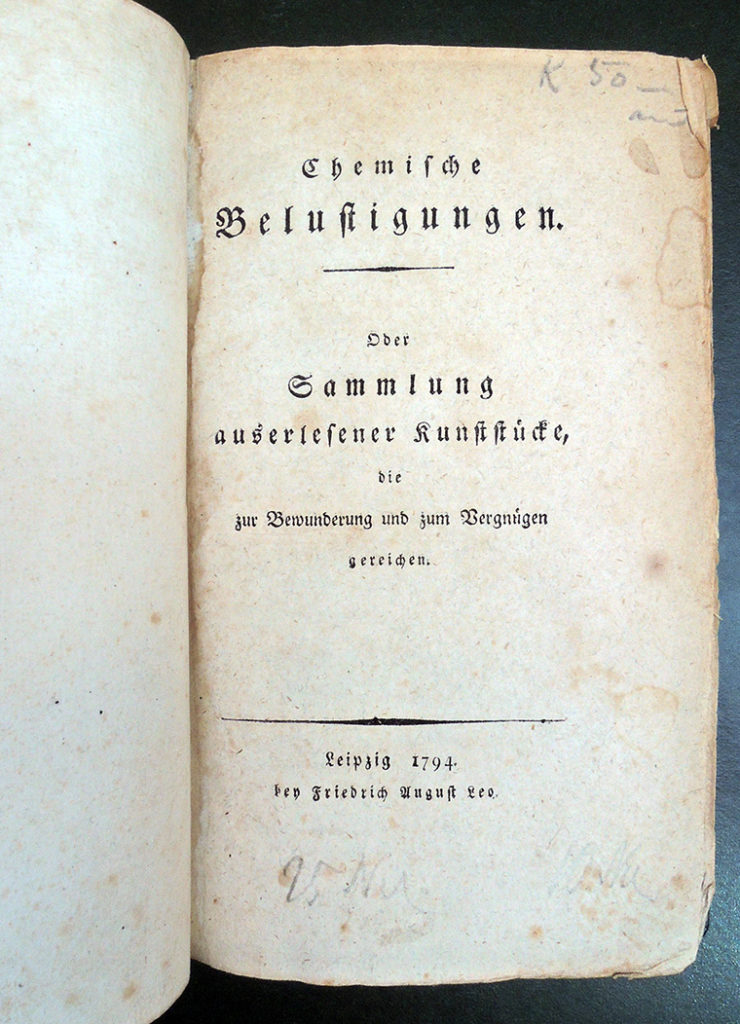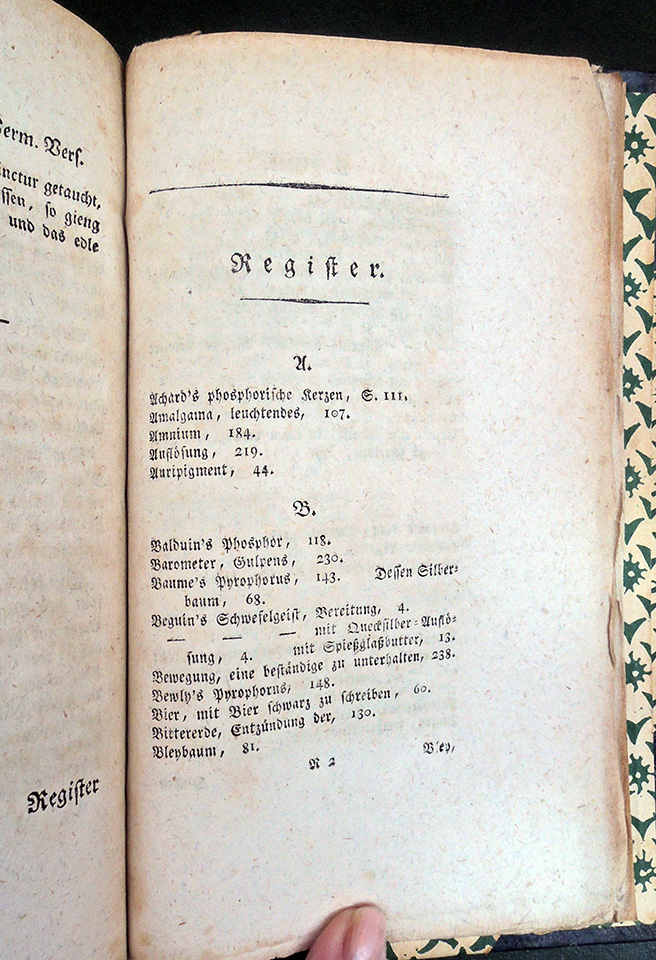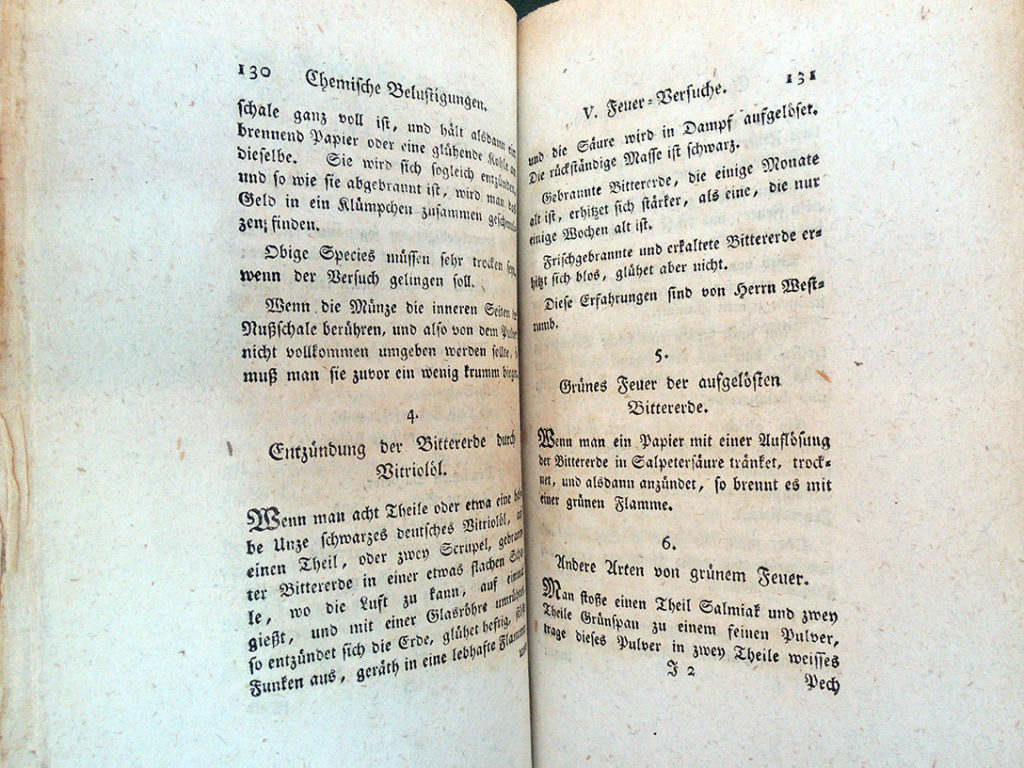

Carl Friedrich August Hochheimer (born 1749), Chemische Belustigungen. Oder Sammlung auserlesener Kunststücke, die zur Bewunderung und zum Vergnügen gereichen [Chemical amusements. Or a collection of exquisite tricks that make for admiration and pleasure] (Leipzig: Friedrich August Leo, 1794). 8vo. Graphic Arts Collection GAX 2019- in process.
C.F.A. Hochheimer, who also wrote under the pseudonym Johann Daniel Hock (CERL Thesaurus https://data.cerl.org/thesaurus/cnp01229497 ), studied in Göttingen with Lichtenberg, then in Leipzig and Erlangen before accepting a lectureship in philosophy and chemistry. He was a prolific author whose books include an instruction manual on color; a handbook on chemistry for farmers, artists, and homemakers; secrets for artists, manufacturers, professionals, and craftsmen: Greek history; mineralogy; fossils; and now in the Graphic Arts Collection: a collection of chemical amusements, magic tricks, and illusions that can be performed by use of chemistry.
This is not a treatise on chemistry but a collection startling effects produced by chemical action, arranged in eight chapters:
1.Tricks with colors
2.Sympathetic inks (a fluid for producing writing that is invisible until brought out by heat, chemicals, etc.: invisible ink)
3.Tree of Diana, et al.
4.Phosphorus
5.Combustion experiments
6.Explosions
7.Gases
8.Miscellaneous experiments including Ingenhousz electrical pistol (originally published in Jan Ingenhousz (1730-1799), Nouvelles expériences et observations sur divers objets de physique (Paris: T. Barrois le jeune, 1785-1789).
“Electricity and chemistry were close partners in those days. Ingenhousz described the making and handling of electrical pistols fired by igniting inflammable gas, ways of obtaining that gas from swamps, ways of making lamps burning in inflammable gas, …”– Geerdt Magiels, From Sunlight to Insight: Jan IngenHousz, the Discovery of Photosynthesis & Science in the Light of Ecology (2010), p. 179.
Chemische Belustigungen should not be confused with the 1817 volume with the same title by Friedrich Christian Accum (1769–1838), which may have based on Hochheimer’s book. The 1802 treatise Dintenbuch; oder: Anweisung, alle schwarze, bunte und sympathetische Dinten zu verfertigen (Instructions on making black, colored, and sympathetic inks; only available at the New York Public Library), is an expanded study based on chapter 2, Invisible inks.
See also:
Giambattista della Porta (approximately 1535-1615), Natural magick in twenty books … wherein are set forth all the riches and delights of the natural sciences (London: Printed for Thomas Young and Samuel Speed …, 1658).
John White (died 1671), A Rich Cabinet, with Variety of Inventions: Unlock’d and Open’d, for the Recreation of Ingenious Spirits at their Vacant Hours. Being Receits and Conceits of Severall Natures, and Fit for Those Who Are Lovers of Natural and Artificial Conclusions . . . [Frontispiece by Thomas Cross, active 1632-1685]. Fourth edition, with many additions (London: printed for William Whitwood at the sign of the Golden Lion in Duck-Lane near Smith-field, 1668). Graphic Arts Collection GAX N-000210



